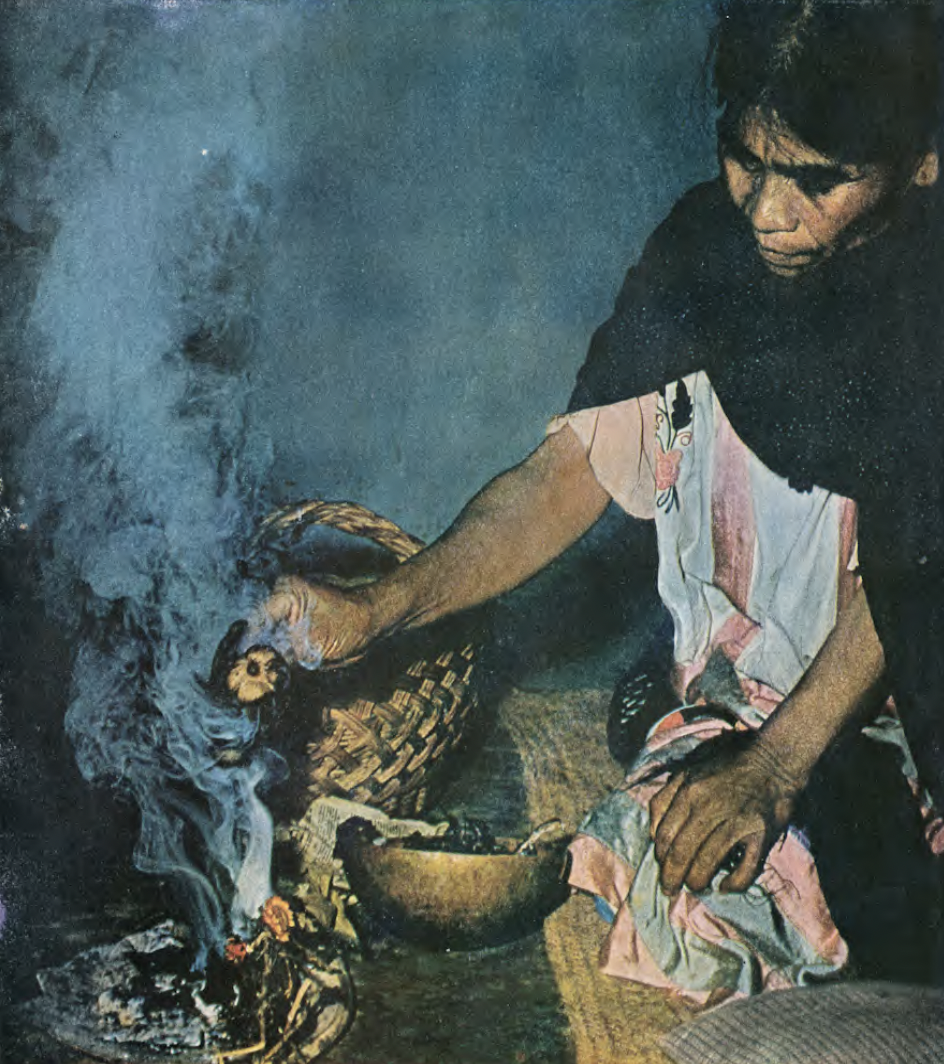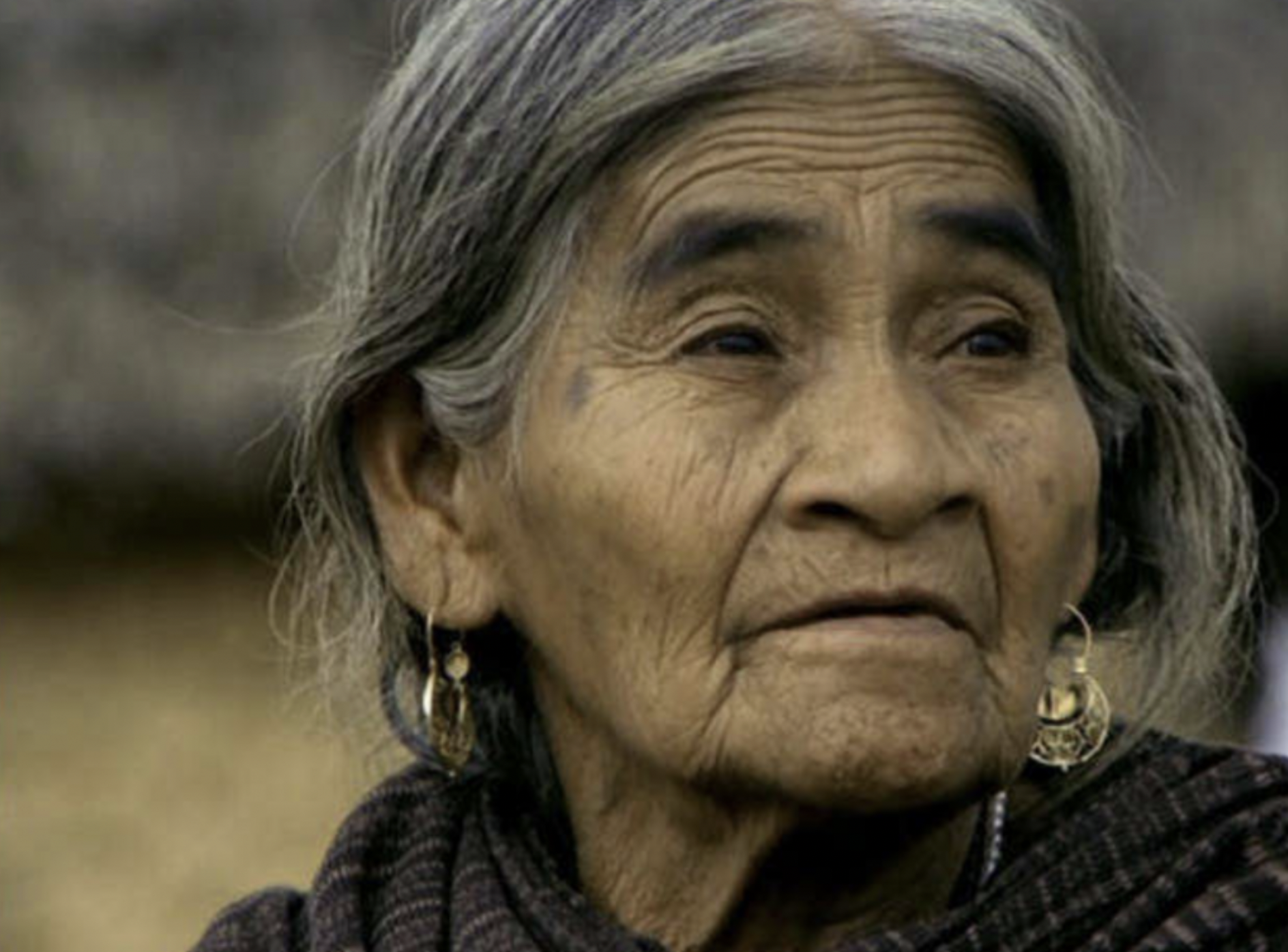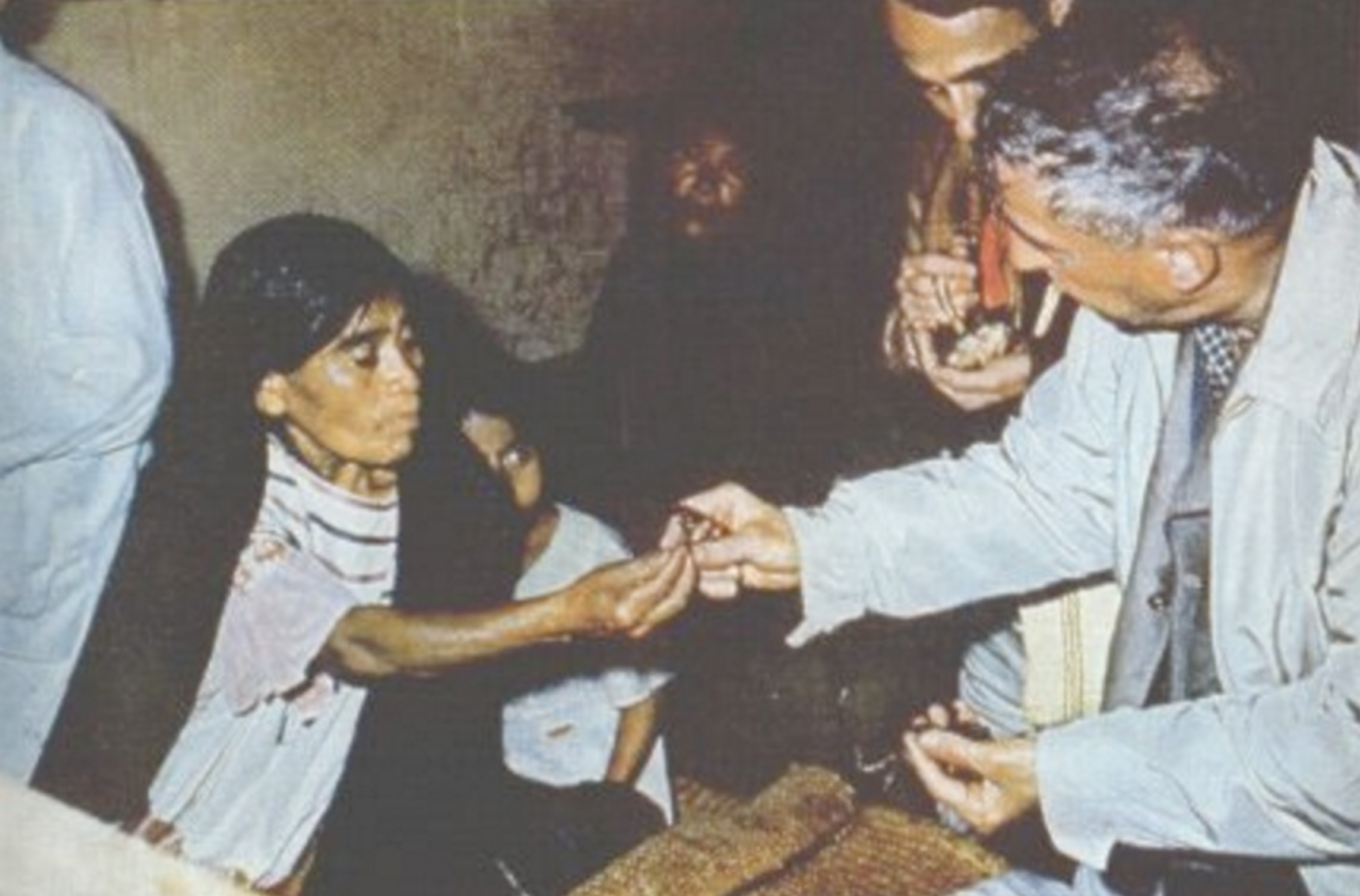
On February 13, 1957, Life magazine published a 15-page article detailing, experientially, Wasson’s first experiences with the shamaness Maria Sabina. The fantastic style of the text, coupled with Richardson’s extraordinary photographs ushered in, with one fell swoop, the age of psychedelics -High Times
A sultry dawn, a hummingbird's heartbeat, the hush of a secret, whispered into the velvet darkness. These are the threads of life that weave together to form the grand tapestry of Maria Sabina, the legendary Mushroom Priestess of Oaxaca. And believe me, hers is a story that leaves the mouth agape, the eyes wider than a peyote button, and the heart humming a tune of mystical intrigue.
The Little Girl Who Talked to Mushrooms
Can you picture it? A young Maria, no higher than a cornstalk, traipsing through the dew-kissed forests of Oaxaca. She was as curious as a cat with two tails, filled with the kind of wonder that makes a grown man yearn for the innocence of youth. And it was there, amidst the chatter of the crickets and the rustle of the leaves, that she first heard the voices.
She claimed they whispered to her, these little fungal philosophers, the sacred psilocybin mushrooms. They spun tales of ancient wisdom and cosmic understanding, their voices as soft as a mother's lullaby.
"The more you go inside the world of teonanácatl, the more things are seen," she would often say. And oh, how she journeyed into that world, with the same wide-eyed wonder as that little girl in the forest.
The Curandera of Sierra Mazateca
As she grew, so did her reputation. Word spread like wildfire through the mountains and valleys, and before you could say "magic mushrooms", Maria Sabina was the talk of the town. People came from far and wide, seeking her wisdom, her healing, her magical mushroom ceremonies. She was a curandera, a healer, but not of the ordinary kind. No, she had a connection, a hotline to the divine, and she used it to heal the soul.
She once said, "I am the woman who looks inside and examines." And that, dear reader, is exactly what she did. She peered into the soul, dissected the psyche, examined the ego, all under the watchful gaze of the sacred mushroom spirits. Her ceremonies, or 'veladas', were as much a performance as they were a ritual, filled with chant and prayer, smoke and shadow.
The Unintentional Psychedelic Pioneer
But, here's the rub. Maria Sabina, the mushroom priestess, the curandera of Sierra Mazateca, never sought the limelight. She didn't send out invitations to her veladas, she didn't advertise her services, she didn't seek fame or fortune. All the same, it found her.
When the West got wind of her, it blew in like a tempest. Scientists, artists, hippies, beatniks, they all flocked to her humble abode in the mountains of Oaxaca. They wanted a taste of the divine, a glimpse of the cosmic truths she'd been privy to. And Maria Sabina, in her infinite wisdom, welcomed them with open arms.
But, can you imagine the turmoil? The quiet village of Huautla de Jiménez, suddenly swamped with Westerners, their loud voices echoing off the mountains, their strange customs unsettling the locals. Maria's world was turned on its head, and yet, she held steadfast, her faith unshaken.
She is often quoted saying, "I didn’t ask for this. The sacred mushrooms took me by the hand and led me to my path." A path that, despite the bumps and bruises, the fame and the fallout, led to a greater understanding of the universe and our place within it.

The Sacred Mushroom and the Smoke Woman
Maria Sabina, born into the Mazatec tribe, held a unique position that we might liken to a bridge between worlds. She once described this ethereal realm, saying, "There is a world beyond ours, a world that is far away, nearby and invisible". A world that to most remains as elusive as a whispered secret, but to Maria, it was as real as the soil beneath her bare feet.
Throughout her life, Maria was known as the "Smoke Woman," a title reflecting her deeply rooted connection to the ethereal. As she would say during her rituals, "Give me! Give me what's true!" And her cigarette, like a faithful oracle, would whisper universal truths through its smoke.
A Child of the Mazatec Mountains
Maria spent her formative years in Huautla, a place nestled deep within the heart of the Mazatec mountain chain in Oaxaca, a land where shamans, wise people, and healers gathered to ask for peace, harmony, and fertility. This was a place steeped in beauty, tradition, and folklore, a perfect breeding ground for a soul as unique as Maria's.
The Beatles and Other Celebrities
Maria's reputation as a spiritual guide was not confined to her homeland. The Western world soon caught wind of this extraordinary woman and her rituals. Rumor has it that even artists like John Lennon and Paul McCartney were drawn to her like moths to a flame. These individuals, along with many others, were fascinated by the spiritual manifestations of ancestral traditions that Maria was known to invoke.
Yet, in the face of such renown, Maria remained true to herself. She had no interest in rubbing shoulders with celebrities, nor did she seek recognition. Instead, she chose to continue living her simple life, a life where she was free to traverse extraordinary worlds.
The Mother of All
Maria was not only a spiritual guide but also a mother to three children. Despite this, she chose to devote her life to her destiny and became a full-time healer after her second husband passed away. She saw herself as a bloodless woman, the mother of all, and the earthly representative of spirituality.
The Healing Little Children
Her healing rituals were renowned, with the sacred mushrooms, or "Little Children" as she referred to them, playing a central role. Maria claimed, "The niños santos (Psilocybe mexicana) heal. They lower fevers, cure colds, and give freedom from toothaches. They pull the evil spirits out of the body or free the spirit of the sick".
In her ceremonies, both the patient and herself would consume the mushrooms, and then, as she put it, throw up all the evilness. In this way, these "Little Children" helped the patient free their body from illnesses.
The Gift of Understanding the Mushrooms
However, Maria believed that not everyone had the ability to understand the language of the mushrooms. She thought that only a select few were born with the gift to truly communicate with them. So, even if one were to participate in countless rituals, without the gift, they would never truly get to converse with the mushrooms.
Maria Sabina was a woman of wisdom and spirituality, a woman who, despite her humble beginnings and simple life, left an indelible mark on the world. Through her, we've been given a glimpse into a world beyond our own, a world filled with universal truths and cosmic understanding. A world that, to Maria, was simply home.

The Mysticism of Maria
Maria Sabina was more than just a woman; she was a phenomenon. In a world where most people are confined to the realm of the seen and known, Maria danced on the edges, her feet planted firmly in the mystery of the unseen and unknown. And yet, as the saying goes, the more things change, the more they stay the same. Despite her spiritual prowess, Maria was still a woman of flesh and blood, still a woman of the earth.
The Non-Canonized Saint
Now, you might be wondering, how does a woman of such spiritual magnitude go unnoticed by religious institutions? Well, the truth is, she didn't. Gordon Wasson, an American researcher who was instrumental in making Maria an international figure, once wrote in a letter to a friend that the Catholic Church should canonize her. He praised Maria for her exemplary character and unwavering faith.
However, despite recognition from the Church, Maria was never canonized. The Church was wary of her association with psychotropic substances and her links to a world of spirituality and sorcery that defied their understanding and control.
The Land of Huahutla
Oaxaca, a state known for its stunning beauty, tradition, and folklore, was Maria's lifelong companion. It was here, in the heart of the Mazatec mountain chain, that Maria called home.
In Huahutla, Maria was more than just a woman; she was a symbol. She was an embodiment of the land's rich traditions and its people's deep spiritual connection. She was a beacon of wisdom and spiritual healing in a world often overshadowed by ignorance and suffering.
The Legacy of Maria
Maria's life was a testament to the power of faith and the human spirit. She was a woman of profound wisdom, a woman who dared to tread where others feared to go. And in the process, she transformed countless lives and left a legacy that continues to inspire.
Maria Sabina, the Smoke Woman, the Mother of all, the Non-Canonized Saint of Huahutla. A woman of extraordinary worlds, a woman of wisdom, a woman of spirituality. A woman who was, in every sense of the word, truly one of a kind.
Maria Sabina, Poet
And then there's, Maria Sabina, the poet of Oaxaca! A magnificent soul who danced with the sacred mushrooms and wove verses that transcended the bounds of ordinary reality. Her poetry, was a kaleidoscope of colors and a symphony of words that caressed the spirit and opened the doors of perception.
Now, some may speak of cultural appropriation, questioning the involvement of outsiders in these sacred rituals that Robert Gordon Wasson’s article for Life magazine introduced to the world. But let me assure you, Maria Sabina welcomed those who approached her with respect and genuine curiosity. It mattered not the person's origin or profession; it was the sincerity of their intentions that Maria Sabina valued.
“…not a poet in any ordinary sense—María Sabina lived out her life in the Oaxacan mountain village of Huautla de Jiménez, and yet her words, always sung or spoken, have carried far and wide, a principal instance and a powerful reminder of how poetry can arise in a context far removed from literature as such. Seeking cures through language—with the help of Psilocybe mushrooms, said to be the source of language itself—she was, as Henry Munn describes her, "a genius [who] emerges from the soil of the communal, religious-therapeutic folk poetry of a native Mexican campesino people." She may also have been, in the words of the Mexican poet Homero Aridjis, "the greatest visionary poet in twentieth-century Latin America." UCPress: Maria Sabina
As I reflect upon Maria Sabina's life, I am reminded of the uniqueness of her being. She was a visionary poet who danced between worlds, a bridge connecting the ordinary and the extraordinary. Like the magic mushrooms that grew in her homeland, she sprouted words that shimmered with a touch of mystery and enchantment. Her poetry carried the spirit of the Mazatec people, a culture steeped in ancient wisdom and a profound connection to nature.
Reports of her poetic uses of the sacred mushrooms reached far and wide, reaching even the ears of the Mexican poet Homero Aridjis. He recognized the significance of her words, how they painted pictures that stirred the imagination and unraveled the hidden threads of the universe.
And yet, let us not forget that Maria Sabina was but one part of a tapestry of wisdom and tradition. Her poetic dance was interwoven with the chants of the curanderos, the healers, and the spirits that guided them. She was a daughter of the Mazatec people, drawing from the collective wisdom of her ancestors and the spirits that spoke through the mushrooms.
"Heal yourself with the light of the sun and the rays of the moon. With the sun of the river and the waterfall. With the swing of the sea and the fluttering of birds. Heal yourself with mint, name, and eucalyptus. Sweetened with lavender, rosemary and chamomile. Hug yourself with the cacao bean and a hint of cinnamon. Put love in tea instead of sugar and drink it looking at the stars. Heal yourself with the kisses that the wind gives you and the hugs of the rain. Stand strong with your bare feet on the ground and with everything that comes it. Be smarter every day by listening to your intuition, looking at the world with your forehead. Jump, dance, sing, so that you live happier. Heal yourself, with beautiful love, and always remember… You are the medicine."
-Maria Sabina
In Conclusion:
Every now and then, as the sun sets over the Sierra Mazateca, I find myself spirited away by deep gratitude for the life and work of Maria Sabina. Ah, Maria! That venerable Mazatec woman, she who danced in the embrace of the "little ones" and let the world in on the secret.
What a riveting story hers was! A simple Mazatec woman, an emissary of the humble mushroom, who threw open the doors to her world for us folks from the North. We came, driven by our curiosity, our quest for spiritual understanding, thirsty for a taste of the divine. And Maria, with her warm heart and wise soul, welcomed us. She shared her precious knowledge, her healing powers, her divine communion with ‘los niños santos' - those holy little ones - with us.
Her mushrooms, they were more than mere fungi. They were Maria's partners in healing, her tools of transcendence, her bridge between the seen and the unseen. As we partook in these sacred rituals, we too were invited to traverse that bridge, to experience the unexperienced, to understand the unfathomable.
Maria wasn't just a healer, she was a torchbearer of a venerable tradition, someone who understood the sacredness and spirituality of the psilocybin mushrooms. She carried that torch high and proud, illuminating the path for all who sought healing and transformation.
Even now, decades after her passing, the ripples of her work continue to spread. Her beloved 'little ones' have now found their way into the halls of modern medicine. The FDA, no less, has recognized the healing potential of psilocybin, naming it a breakthrough therapy for severe depression. And to think, it all started with a humble Mazatec woman in the mountains of Oaxaca!
As I sit here, my heart smiles with gratitude. For Maria Sabina. For her selfless dedication to her calling. For her courage in sharing her world with us. For her enduring legacy that continues to inspire, heal, and transform. She was, and continues to be, a beacon of light, a testament to the power of the humble mushroom, and a reminder of the deep spiritual roots that connect us all. Thank you, Maria.
"You are a sacred, worthy, luminous being. You are love and your love is for giving and receiving."
– Dr. Tom Pinkson
Written by Sergio Nikita Lialin
Sergio is a psychedelic preparation, guidance, and integration coach with over 30 years of experience. His highly unique approach blends the ancient wisdom of indigenous cultures of Latin America, where he studied extensively, with Western training in integrative medicine and psychology.
Bridging traditional guidance with neuro-linguistic programming (NLP) and modern psychology, he has developed a proprietary and transformative coaching style. As a lifelong healer, artist, and spiritual counselor, he has compassionately guided individuals and couples toward healing and fulfillment, drawing inspiration from his mentorships in Mexico, Peru, Brazil, and Colombia. He is currently mentoring mental health professionals in psychedelic-assisted therapy.
He can be reached at PsychedelicTherapyMentor@Proton.me